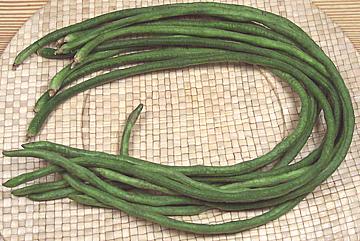 Unlike it's close relative the African
Black-eyed Pea, these beans are grown only for the pod.
These pods are much meatier than the black-eye pod, with small seeds
spaced far apart. The flavor is quite similar. While often called
Yardlong Beans they actually top out at about 28 inches. The photo
specimens were typically 3/8 inch in diameter and the longest was 26
inches, but they are commonly a little smaller.
Unlike it's close relative the African
Black-eyed Pea, these beans are grown only for the pod.
These pods are much meatier than the black-eye pod, with small seeds
spaced far apart. The flavor is quite similar. While often called
Yardlong Beans they actually top out at about 28 inches. The photo
specimens were typically 3/8 inch in diameter and the longest was 26
inches, but they are commonly a little smaller.
There is also a "white" variety, actually a light yellow-green, but these are less available, more expensive and found only occasionally in large Asian markets. These beans are important to the cuisines of Asia, particularly Southeast Asia, so are widely grown in California. They are a traditional food in tropical Africa and may have originated there. They have also become quite popular in Caribbean cuisines.
More on Beans, Peas & Lentils.
Long beans are eaten raw in salads, particularly in Thailand, where they will be quite sweet compared to other beans, but they are more commonly cooked, throughout southern India and Southeast Asia. I use them in African or Asian stew that calls for Green Beans, as they hold up to long cooking much better.